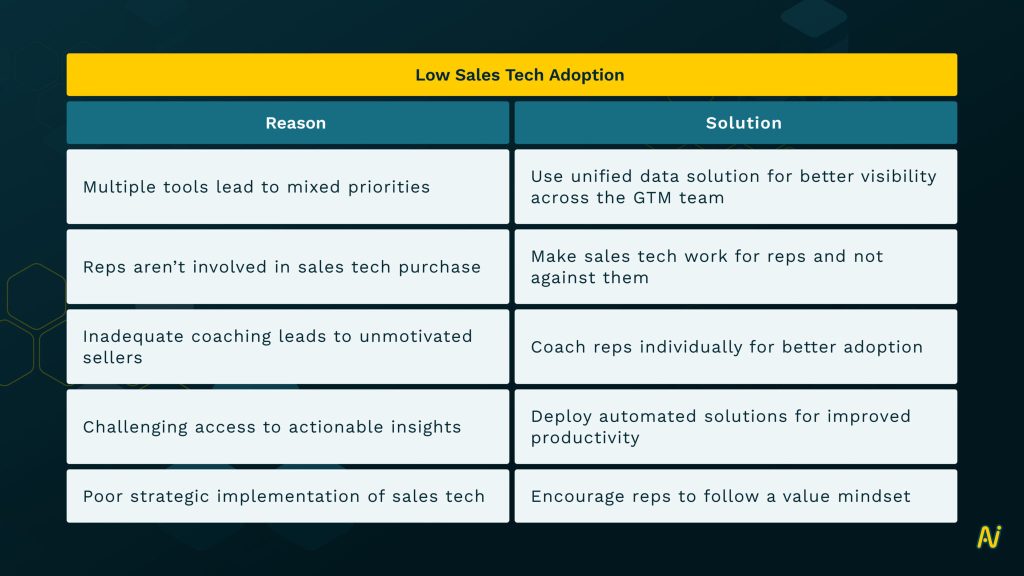3. The Problem: Inadequate Coaching Leads to Unmotivated Sellers
Each rep may have different expectations and needs from the same software in a real-world setting. For example, Rep A is great at cold calling, so they’ll want the software to be seamless with contact data. On the other hand, Rep B is better at upselling to existing customers and will need prospect history.
You can’t address both salespersons’ requirements in a general training session. If reps don’t receive adequate one-on-one coaching, they won’t know which features suit them best.
Eventually, they lose motivation to keep performing well and achieve quotas, making them less productive. About 38% of sellers feel inadequate coaching is a barrier to success at work.
Moreover, a single training session isn’t enough to boost daily adoption. Amidst a host of selling activities and complex cross-functional processes, reps may not implement the training practically. Also, they can’t retain extensive information for long; 87% of sales reps forget the information they learn within a month.
You may also rely on annual revenue, win rates, sales cycle length, and quota attainment to train reps – all of which are lagging indicators. Coaching based on these indicators is reactive, not future-forward, leaving reps indecisive when a new situation (like a pandemic) arises.
The Fix: Coach Reps Individually
High-performing sales teams are backed by coaching. As much as 80% of these teams rate their coaching processes as outstanding.
To begin with, you can uniquely showcase the tool’s benefits for each rep. It gives them deeper insight into features most useful to them. If we revisit the previous example, Rep A can use lead qualification and sales enablement to take on cold calling. Rep B will do better with pipeline building and management to find hidden upselling opportunities.
Second, coaching lets you communicate with reps and drive performance back to shared goals. If you see a salesperson struggling with selling to a prospect, you can show how the rep can provide value through the tool. To make this possible, your sales software must enable real-time feedback.
Lastly, tech is regularly updated to keep up with changing needs. Continued coaching keeps reps up to speed with newer features, making them agile and responsive.
4. The Problem: Challenging Access to Actionable Insights
Most CRMs need a certain amount of manual intervention to input, store, or update account data. Sales reps may log in contact information, emails, phone call summaries, and meetings’ talking points, which become a part of their daily routine.
But they’re only human. Reps could make errors while entering data, more so when using multiple software. Inaccurate or incomplete data disrupts the entire CRM system and gradually affects reps’ confidence in the tool. The consequences of dirty data are also monetarily significant, causing organizations to lose an average of $15 million yearly.
With some tools, sellers must dig through heaps of data to get insight. Human perspectives are subjective in nature, making them prone to errors.
Reps also have little time to waste training for new sales solutions, only to jump from one tool to another between buyer interactions. Not only do they miss actionable insights and quota attainment, but they also spend additional hours on non-sales tasks, subsequently increasing costs.
The Fix: Automated Solution for Improved Productivity
An automated solution identifies CRM gaps, captures missing data, and adds it to the system without rep intervention, leading to a complete pipeline. More activity data also gives reps better chances at focusing on customers with high purchase intent.
Sellers don’t need to log in meeting details after each buyer interaction. Conversational intelligence automatically transcribes or records each discussion and pulls out actionable insights. Moreover, these solutions automate documentation processes for proposals, pitches, quotations, and service agreements. These features help reps close deals quicker.
AI mines data from sales tools for improving decision-making, supporting coaching, setting selling priorities, and monitoring performance in real time. Reps can stop worrying about creating additional charts and spreadsheets in conventional systems; instead, they focus on closing deals for higher revenue.
Nektar makes this easier with deal alerts and deal health scores to quantify high purchase intent opportunities into sales.
- Deal alerts can be personalized for you, depending on your sales process. Reps can act on an alert to convert an opportunity, and you can provide coaching with deal guidance for successful closure.
- Deal health scores capture 25+ parameters, including deal momentum, buyer-seller engagement, and playbook compliance. This can also be customized for your processes, giving you the most reliable status of ongoing deals.
5. The Problem: Poor Strategic Implementation
Resistance to change is an ongoing problem across businesses. Regarding sales, reps can get too comfortable using traditional tools like spreadsheets (which they’re highly familiar with). Something new they’ve never used before can be more complicated.
Other times, reps feel that CRMs monitor their activities and stack up evidence that managers could use against them later. And so, they continue working with conventional software even if you’ve provided new tools.
But conventional tools don’t provide in-depth analytics and encourage dirty data buildup. This results in poor insights and, subsequently, poor decision-making. Running reports and monitoring performance also becomes challenging, leading to higher CAC, lower conversion, reduced revenue, and poor ROI.
Sometimes, leaders must show reps the strategic value of implementing sales tools. If you can’t demonstrate how these tools achieve KPIs more effectively, your reps are less likely to adopt the technology.
Also, sales tools must enable smooth collaboration between the team, managers, and cross-functional departments.
The Fix: Encourage Them to Adopt a Value Mindset
For reps to adopt a tool, getting them to understand its ” need ” is key. You can demonstrate how a tool will add value to their process, leading to higher win rates and revenue. Further coaching will guide the reps even after initial training is complete. So they can continue unlocking new use cases from sales tech.
But avoid overloading reps with too many benefits. As discussed previously, reps don’t retain too much information for long. They need to practice these benefits to adopt a tool fully.
Regarding strategic insights, AI captures and analyzes the data, making it less prone to errors and supporting sound decision-making. Clean data gives sellers access to otherwise nuanced and hidden insights. Ultimately, your reps can maximize these insights to improve ROI and earn better incentives.
Another way to encourage a value mindset is by setting expectations clearly and providing incentives to reps who maintain them. You could also simplify their workflows, share actionable intelligence, give complete and current contact information, and share contextually relevant best practices.
Further, by aligning with cross-functional departments like marketing and customer success, sales can evaluate the entire buyer journey and optimize several customer touchpoints for more effective closure.
So, how do you select the right sales tech for your reps that makes these fixes a reality?




